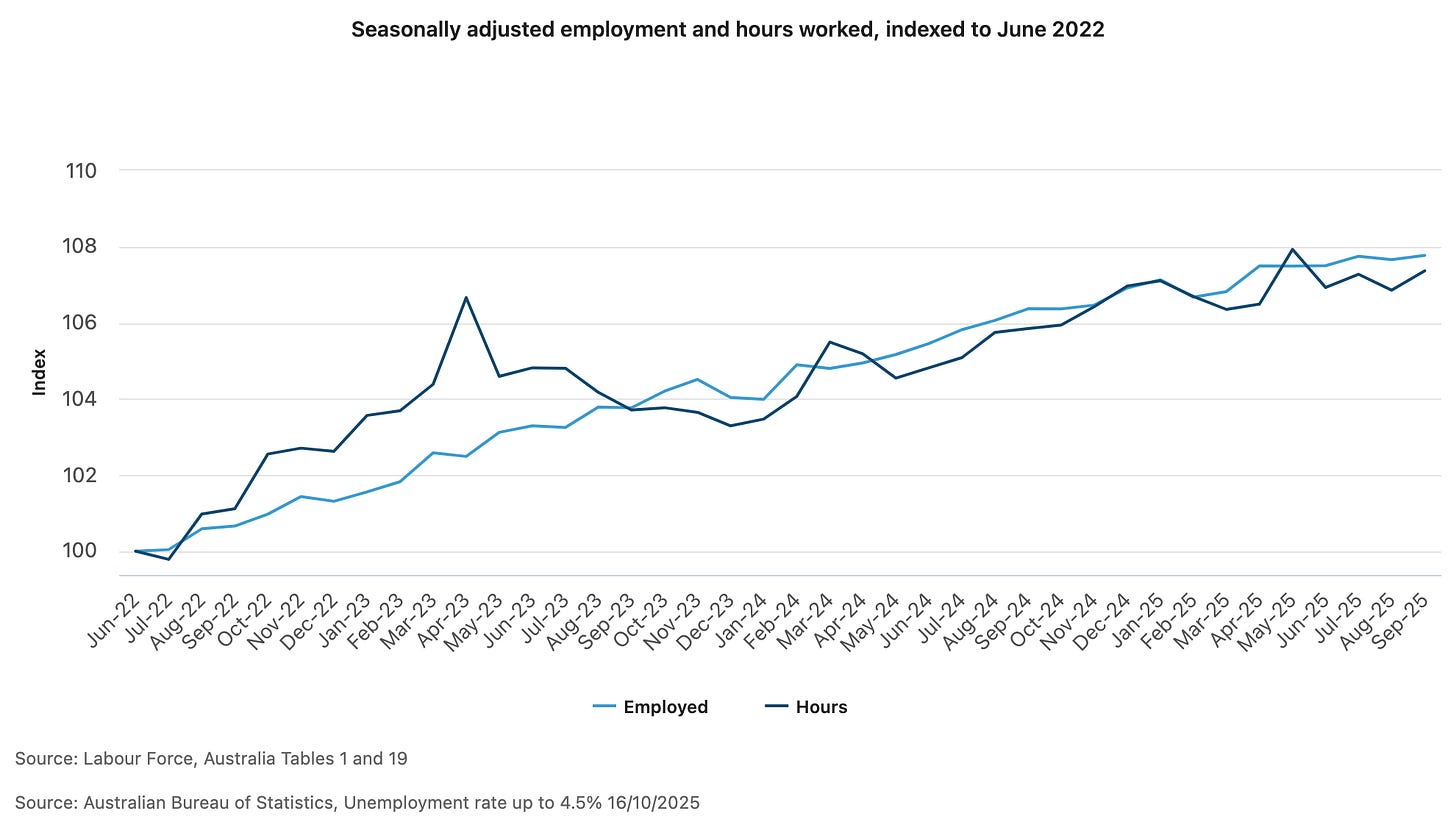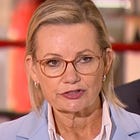Australia’s Unemployment Rate Jumps to 4.5%, Highest in Nearly Four Years
This piece is freely available to read. Become a paid subscriber today and help keep Mencari News financially afloat so that we can continue to pay our writers for their insight and expertise.
Today’s Article is brought to you by Empower your podcasting vision with a suite of creative solutions at your fingertips.
Australia’s unemployment rate climbed to 4.5% in September, marking the highest level since November 2021 and signaling potential challenges ahead for the nation’s labor market, according to data released Wednesday by the Australian Bureau of Statistics.
The seasonally adjusted rate rose from a revised 4.3% in August, with 34,000 more Australians joining the ranks of the unemployed during the month. The increase comes as the country’s workforce continues to expand, with the participation rate ticking up to 67.0%.
“This is the highest seasonally adjusted unemployment rate recorded since November 2021,” said Sean Crick, head of labour statistics at the ABS. “There were 34,000 more unemployed people in September. The number of employed people also grew, up 15,000 in the same period.”
The dual increase in both unemployment and employment reflects a growing workforce, with more Australians actively seeking work. The participation rate rose by 0.1 percentage points to 67.0%, though it remains below the record high of 67.2% recorded at the beginning of 2025.
The employment-to-population ratio held steady at 64.0%, unchanged from the previous month.
Truth matters. Quality journalism costs.
Your subscription to Mencari directly funds the investigative reporting our democracy needs. For less than a coffee per week, you enable our journalists to uncover stories that powerful interests would rather keep hidden. There is no corporate influence involved. No compromises. Just honest journalism when we need it most.
Not ready to be paid subscribe, but appreciate the newsletter ? Grab us a beer or snag the exclusive ad spot at the top of next week's newsletter.
Job Seekers Rise Across Demographics
Men bore the brunt of September’s unemployment surge, with 24,000 more males out of work, bringing the total to 370,000 unemployed men. Female unemployment increased by 10,000 to reach 314,000.
The gender breakdown reveals shifting dynamics in Australia’s labor market, with men representing nearly 71% of the month’s increase in unemployment despite making up roughly 54% of total job seekers.
Full-time employment posted modest gains, rising by 9,000 positions in September. However, the increase masked divergent trends between men and women. Full-time employed males increased by 23,000, while full-time employed females decreased by 15,000.
Part-time employment climbed by 6,000, driven entirely by women taking on more part-time roles. Females employed part-time rose by 19,000, offsetting a decline of 13,000 part-time employed males.
The shifts suggest potential challenges for women seeking full-time work, even as overall employment numbers edge higher.
Work Hours Outpace Job Growth
Hours worked rose by 0.5% in September, outstripping the 0.1% rise in employment. The stronger growth in hours compared to headcount suggests existing workers may be taking on additional shifts or longer workweeks as businesses manage labor demands.
“As a result of these increases, the participation rate rose by 0.1 percentage points to 67.0%, although this is below the record high of 67.2% we saw at the beginning of the year,” Crick said.
The September survey reference period ran from Aug. 31 through Sept. 13, capturing a snapshot of Australia’s labor market during a period of economic uncertainty.
Underemployment Pressures Mount
Beyond traditional unemployment, broader measures of labor underutilization also showed stress. The underemployment rate rose by 0.2 percentage points to 5.9% in September. Underemployment captures workers who have jobs but want more hours than they’re currently getting.
Despite the monthly increase, underemployment remains 0.3 percentage points lower than September 2024 and 2.8 percentage points below the March 2020 level during the early months of the COVID-19 pandemic.
The underutilisation rate, which combines unemployment and underemployment into a single measure of total labor slack, jumped by 0.4 percentage points to 10.4%. This comprehensive metric now sits 0.1 percentage points higher than September 2024, though it remains 3.5 percentage points below the March 2020 reading.
The rise in underutilisation suggests challenges extend beyond those actively seeking work to include employed Australians struggling to secure sufficient hours.
Trend Data Shows Slower Growth
Underlying trend data, which smooths out monthly volatility to reveal longer-term patterns, painted a picture of gradual labor market cooling. Trend employment grew by around 20,000 people, or 0.1%, in September. Over the past 12 months, trend employment has risen 1.5%.
Monthly hours worked rose by 0.1% in trend terms, matching the monthly growth in people employed. The annual growth rate of both hours worked and people employed stood at 1.5%.
“The trend unemployment rate remained at 4.3% in September,” Crick said. “In trend terms, participation rate remained at 66.9% in September, while the employment-to-population ratio stayed at 64.0%.”
The trend underemployment rate held steady at 5.9%, and the trend underutilisation rate remained at 10.2%, suggesting the monthly jumps in the seasonally adjusted figures may moderate in coming months.
Regional Data Coming Soon
More detailed information, including regional labor market breakdowns, will become available in the upcoming September 2025 issue of Labour Force, Australia, Detailed, scheduled for release Thursday, Oct. 23. The detailed release typically provides state-by-state unemployment rates and industry-specific employment trends.
The Oct. 16 release marks the latest in the ABS’s monthly labor force survey, which tracks employment conditions across the nation. The October survey reference period runs from Sept. 28 through Oct. 11, with results expected in mid-November.
The ABS defines population as the resident civilian population aged 15 years and over when reporting labour force statistics. The survey excludes military personnel and captures a snapshot of employment status during a specific two-week reference period each month.
Seasonal Adjustments Updated
The seasonal adjustment of labor force estimates is updated each month, which can result in revisions to prior months’ data. Revisions to August 2025 figures were primarily driven by this updating of seasonal adjustment, the ABS noted.
Seasonal adjustment removes predictable patterns that occur at specific times of the year, such as increased retail hiring before Christmas or student job-seeking during summer breaks. The process allows for more accurate month-to-month comparisons but means historical figures can shift as new data becomes available.
The bureau thanked Australians for their continued participation in the monthly survey, which relies on voluntary responses from households across the country to build a comprehensive picture of the nation’s labor market.
Looking Ahead
The September figures arrive as Australia navigates a complex economic environment. With unemployment at its highest level in nearly four years, policymakers and economists will watch closely for signs of further deterioration or stabilization in coming months.
The October data, covering the period through mid-October, will provide the next major checkpoint for assessing whether September’s jump represents a temporary spike or the beginning of a sustained trend. Regional data due Oct. 23 will offer additional granularity on which parts of the country are experiencing the most significant labor market shifts.
For now, the numbers show a workforce that’s growing but struggling to absorb all those seeking work, with particular challenges emerging for men seeking employment and women seeking full-time positions. The 4.5% unemployment rate, while still low by historical standards, marks a clear departure from the sub-4% readings that characterized much of 2022 and early 2023.
Sustaining Mencari Requires Your Support
Independent journalism costs money. Help us continue delivering in-depth investigations and unfiltered commentary on the world's real stories. Your financial contribution enables thorough investigative work and thoughtful analysis, all supported by a dedicated community committed to accuracy and transparency.
Subscribe today to unlock our full archive of investigative reporting and fearless analysis. Subscribing to independent media outlets represents more than just information consumption—it embodies a commitment to factual reporting.
As well as knowing you’re keeping Mencari (Australia) alive, you’ll also get:
Get breaking news AS IT HAPPENS - Gain instant access to our real-time coverage and analysis when major stories break, keeping you ahead of the curve
Unlock our COMPLETE content library - Enjoy unlimited access to every newsletter, podcast episode, and exclusive archive—all seamlessly available in your favorite podcast apps.
Join the conversation that matters - Be part of our vibrant community with full commenting privileges on all content, directly supporting The Evening Post (Australia)
Catch up on some of Mencari’s recent stories:
It only takes a minute to help us investigate fearlessly and expose lies and wrongdoing to hold power accountable. Thanks!








